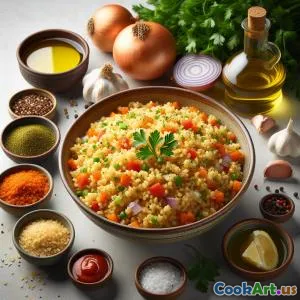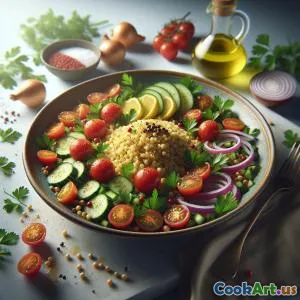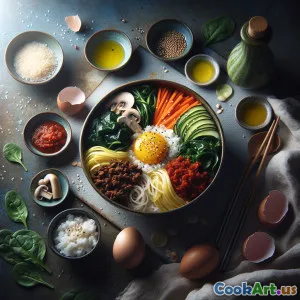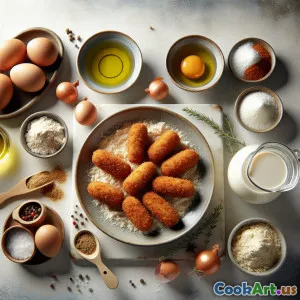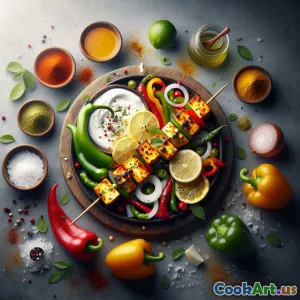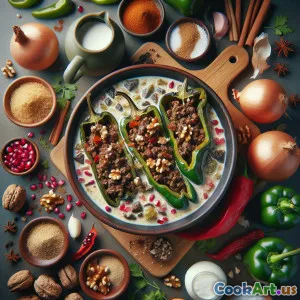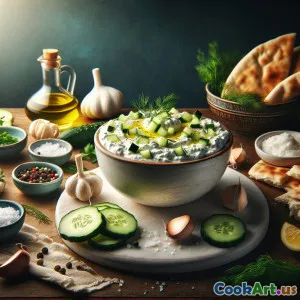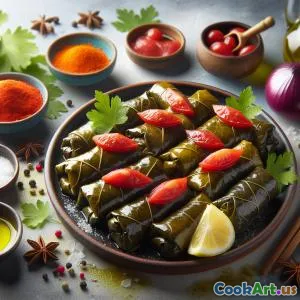
Savory Stuffed Grape Leaves: Dolma Recipe
(0 Reviews)Ingredients
-
300 grams Grape leaves
(Use jarred or fresh, rinsed well)
-
200 grams Rice
(Short grain rice preferred)
-
1 large Onion
(Finely chopped)
-
50 grams Fresh parsley
(Chopped)
-
30 grams Fresh dill
(Chopped)
-
2 tbsp Tomato paste
(Adds flavor and moisture)
-
50 ml Lemon juice
(Freshly squeezed for best flavor)
-
1 tsp Salt
(To taste)
-
1/2 tsp Black pepper
(Freshly ground)
-
3 tbsp Olive oil
(For drizzling)
(Use jarred or fresh, rinsed well)
(Short grain rice preferred)
(Finely chopped)
(Chopped)
(Chopped)
(Adds flavor and moisture)
(Freshly squeezed for best flavor)
(To taste)
(Freshly ground)
(For drizzling)
Nutrition
- Servings: 6
- Serving Size: 4 dolmas (150g)
- Calories: 320 kcal
- Carbohydrates: 50 g
- Protein: 7 g
- Fat: 10 g
- Fiber: 4 g
- Sugar: 3 g
- Sodium: 420 mg
- Cholesterol: 0 mg
- Calcium: 80 mg
- Iron: 1.5 mg
Instructions
-
1 - Prepare the Filling:
In a pan, sauté the chopped onion in olive oil until translucent. Add rice and stir for 2 minutes. Mix in parsley, dill, tomato paste, lemon juice, salt, and pepper.
-
2 - Prepare Grape Leaves:
If using jarred grape leaves, rinse them under cold water and gently separate. If fresh, blanch them in boiling water for 2 minutes.
-
3 - Stuff the Leaves:
Lay a grape leaf vein side up, add a spoonful of filling at the base, fold the sides over the filling, then roll tightly from the base to the tip.
-
4 - Cook Dolmas:
Place stuffed dolmas seam side down in a pot. Add water to cover, drizzle with olive oil, and simmer on low for 30 minutes.
-
5 - Serve:
Let the dolmas cool slightly before serving. Garnish with lemon wedges and additional herbs if desired.
In a pan, sauté the chopped onion in olive oil until translucent. Add rice and stir for 2 minutes. Mix in parsley, dill, tomato paste, lemon juice, salt, and pepper.
If using jarred grape leaves, rinse them under cold water and gently separate. If fresh, blanch them in boiling water for 2 minutes.
Lay a grape leaf vein side up, add a spoonful of filling at the base, fold the sides over the filling, then roll tightly from the base to the tip.
Place stuffed dolmas seam side down in a pot. Add water to cover, drizzle with olive oil, and simmer on low for 30 minutes.
Let the dolmas cool slightly before serving. Garnish with lemon wedges and additional herbs if desired.
More About: Savory Stuffed Grape Leaves: Dolma Recipe
Dolma: A Culinary Journey Through Tradition and Flavor
Dolma, often considered a quintessential dish in Mediterranean and Middle Eastern cuisines, has its roots in ancient culinary traditions. The name 'Dolma' comes from the Turkish verb 'dolmak', which means 'to be filled'. This dish typically consists of grape leaves stuffed with a savory mixture of rice, herbs, and spices, reflecting the rich agricultural heritage of the region.
The preparation of Dolma can vary from family to family, with each cook adding their unique touch. The most common fillings include rice, ground meat, and various spices, often accompanied by fresh herbs like dill and parsley. This dish is not just about flavor; it also embodies the concept of family and togetherness. Traditionally served during gatherings, Dolma is a symbol of hospitality in Turkish culture.
One of the unique aspects of Dolma is its versatility. You can make vegetarian versions as well as those with meat, catering to different dietary preferences. Moreover, Dolma can be served hot or cold, making it suitable for any occasion—be it a festive gathering or a simple weeknight dinner.
When cooking Dolma, the key is to ensure the grape leaves are tender and pliable, allowing for easy rolling. If you are using jarred leaves, rinsing them thoroughly is essential to remove excess brine that can overpower the dish. Fresh grape leaves, when in season, can be a delightful alternative, providing a milder flavor.
In conclusion, Dolma is more than just a meal; it is a delightful experience that connects us to the rich traditions of Mediterranean and Middle Eastern cultures. Whether you're enjoying it as an appetizer, a main course, or even as a snack, each bite tells a story of heritage, flavor, and love.


